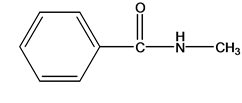
Concept explainers
a.
Interpretation:
The conversion of N-methylbenzylamine to given compound has to be explained.
Concept introduction:
The molecular formula of N-methylbenzamide is

b.
Interpretation:
The conversion of N-methylbenzylamine to benzoic acid has to be explained.
Concept introduction:
The molecular formula of N-methylbenzamide is

c.
Interpretation:
The conversion of N-methylbenzylamine to methyl benzoate has to be explained.
Concept introduction:
The molecular formula of N-methylbenzamide is

d.
Interpretation:
The conversion of N-methylbenzylamine to benzyl alcohol has to be explained.
Concept introduction:
The molecular formula of N-methylbenzamide is

Want to see the full answer?
Check out a sample textbook solution
Chapter 16 Solutions
ORGANIC CHEMISTRY W/ST.GDE W/ACCESS
- The hydrolysis of an amide in acidic conditions forms A. a carboxylate salt and an alcohol B. a carboxylate salt and an amine C. an alcohol and an amine salt (an ammonium ion) D. a carboxylic acid and an amine salt (an ammonium ion)arrow_forward6. The reaction between aniline and nitrous acid at low temperature yields A) an N-nitroso amine B) a diazonium salt C) a nitrile D) an amine nitrite salt 7. An organic nitrogen compound, X, gives ammonia on warming with dilute aqueous sodium hydroxide, X could be A) ethanamide B) ethylamine C) phenylamine D) amino ethanoic acidarrow_forwardDescribe the reaction when a. Formaldehyde mixed with a fainty pink solution of potassium permanganate with a few drops of sulfuric acid. b. Acetaldehyde mixed with a fainty pink solution of potassium permanganate with a few drops of sulfuric acid. c. Benzaldehyde mixed with a fainty pink solution of potassium permanganate with a few drops of sulfuric acid.arrow_forward
- Which of the following compounds will NOT test positive in a hydroxamic test? a. butanoic acid b. butanoyl chloride c. butyl ethanoate d. butanoic acid anhydridearrow_forwardReduction of an alkyl azide results in the formation of —-. A. an imine B. an oxime C. a tertiary amine D. a secondary amine E. a primary aminearrow_forwardDraw a structure corresponding to each name. a. 2,4-dimethyl-3-hexanamine b. N-methylpentylamine c. N-isopropyl-p-nitroaniline d. N-methylpiperidine e. N,N-dimethylethylamine f. 2-aminocyclohexanone g. N-methylaniline h. m-ethylanilinearrow_forward
- 1. A pleasant smelling liquid having a boiling point of 101°C. What is the structure of this compound? Major IR Absorptions Major lons in the MS 2880-2980 cm-¹ 29 41 1737 (str) 1194 (str) 1166 (str) 56 57 (base) 73 85 101 (small) 116 (molecular ion) 100 1737 500 vavenumber cm-1 157 Transmittance %T ģ 0. liquid film sample 100 80 60 4000 Relative Intensity 9 20 0 10 20 2977 9000 2876 30 4. 40 2000 50 56 60 m/z 70 1500 73 80 1194 85 1166 90 1000 101 repla 100 110 M: 116arrow_forwardInstructions: DRAW a structure corresponding to each name a. 3-hexanamine b. N-methylpentylamine c. p-nitroaniline d. N-methylpiperidine e. N,N-dimethylethylamine f. 2-aminocyclohexanone g. 1-propylcyclohexanamine h. N-propylanilinearrow_forwardInstructions: Give an acceptable name for eachester. A. CH, CH2)CO,CH, B. COCHỊCH, C. CH₂CH₂CH₂CH₂COOCH₂CH₂CH₂ Instructions: Give the structure corresponding to each name. a. propyl propanoate b. butyl acetate c. ethyl hexanoate d. methyl benzoate Instructions: Give an acceptable name for each amide A. CH₂CH₂CH₂CH₂ NH₂ Instructions: Draw the structure of each amide. A. N,N-dimethylacetamidearrow_forward
- When benzaldehyde is added to the reagent prepared by reacting ethyl-2-bromoacetate with metallic zinc in benzene, which of the following molecules is obtained when the product is finally acidified.A. 3-phenyl-3-hydroxy-3-propanoate B. ethyl-3-phenylpropanoate C. ethyl-3-hydroxypropanoate D. ethyl-3-phenylpropanoate E ethyl-3-hydroxy-3-phenylpropanoatearrow_forwardEsters and amides are most easily made by nucleophilic acyl substitution reactions on… A. alcohols B. acid chlorides C. acid anhydrides D. carboxylates E. carboxylic acidsarrow_forwardb. Which of the following is the structure of acetic anhydride? si OH c. When 4-ethoxyaniline reacts with acetic anhydride, what new functional group or type of compound is formed? O acid anhydride acetal amide O esterarrow_forward
 Chemistry for Today: General, Organic, and Bioche...ChemistryISBN:9781305960060Author:Spencer L. Seager, Michael R. Slabaugh, Maren S. HansenPublisher:Cengage Learning
Chemistry for Today: General, Organic, and Bioche...ChemistryISBN:9781305960060Author:Spencer L. Seager, Michael R. Slabaugh, Maren S. HansenPublisher:Cengage Learning Organic ChemistryChemistryISBN:9781305580350Author:William H. Brown, Brent L. Iverson, Eric Anslyn, Christopher S. FootePublisher:Cengage Learning
Organic ChemistryChemistryISBN:9781305580350Author:William H. Brown, Brent L. Iverson, Eric Anslyn, Christopher S. FootePublisher:Cengage Learning

